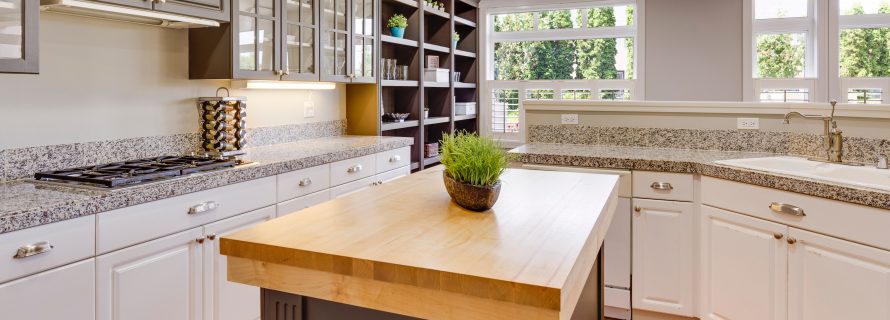Comparing Countertop Material Options for Your Kitchen

When renovating your kitchen, there’s no decision quite as exciting as choosing the countertop material. The countertop sets the tone for the whole room, so it’s essential to select a material that makes sense for you.
There’s no shortage of fantastic material options on the market. Some are better for the budget, while others are better for aesthetics. Maintenance level is also a top thing to consider when weighing out potential materials.
Before you get started, you have to ask yourself a few questions:
- How do I want my countertop to look?
- How much maintenance and upkeep am I comfortable with?
- What is my budget?
Once you have answers to these questions, it’s much easier to navigate and weed through your potential choices. Let’s look at a few of the most popular materials out there so you can begin to compare your options.
Option One: Laminate
If low-cost is at the top of your priority list, you can’t go wrong with a laminate countertop. Laminate counters are straightforward to install, so if you’re a DIYer, laminate is a fantastic choice. While this material gets a bad rap, it’s quality and versatility has improved dramatically over the years. Nowadays, laminate comes in a variety of different colors and textures, and it’s a breeze to maintain.
Option Two: Solid Surface
Solid surface kitchen countertops are a top choice for homeowners who are looking for easy-maintenance countertops. Solid surface is water-resistant and relatively durable. What makes solid surface counters unique is that they’re cut for the space, so there are no visible seams, which results in a uniform and sleek appearance. Solid surface is created by combining acrylic polymers with stone-derived minerals. The final product is often a stark white, easy-to-clean, functional counter that’s easy on the wallet.
Option Three: Granite
If you want luxury, go for granite. Granite has become the premier choice for homeowners who want a luxurious, one-of-a-kind countertop. Granite is a durable natural stone that resists scratches, stains, and heat. The one hang-up with granite is that it’s porous, so liquids can be a problem. Granite also requires special care in cleaning and maintenance. However, there’s no substitute for this material, so if you love the look and don’t mind the price, granite is a terrific choice.
Option Four: Quartz
Quartz is growing in popularity and has become the go-to alternative for folks who want the look of natural stone without the maintenance issues. Quartz is an engineered stone that is more durable than granite, and it resists moisture. It also has a uniform appearance, so if you ever need to repair your quartz counter, it’s much easier than repairing a granite or marble one. The only real pitfall to quartz is its price tag. So, if you want to go with quartz, be prepared to spend a bit.
Option Five: Concrete
Concrete is the new alternative for people who want the durability of natural stone without the cost. Concrete polishes and paints can transform plain concrete to resemble natural stone, or they can help it take on a look of its own. Concrete can be challenging to install, and because it’s porous, you’ll have to reseal it regularly to keep it from getting damaged.
Option Six: Metal
Stainless steel countertops are standard in commercial kitchens, but they’re making their way into residential homes, too. You can choose other metals aside from stainless steel, but it’ll be more challenging to find and maintain. Stainless steel, on the other hand, is durable and simple to clean. The only complaint from homeowners is that fingerprints are very visible on steel counters, so if you have little ones, you might want to avoid this material. Also, the cost can vary dramatically from vendor to vendor, so be sure to shop around if you go this route.
Option Seven: Wood
Wood counters are rustic, charming, cheap, and easy to install. Throw on a coat of paint or a different stain, and you can make your wooden counter match any aesthetic. The problem with wood is that it’s susceptible to damage. Wood is porous, so it can absorb moisture. It’s also in danger of collecting scratches and stains. However, if you abide by proper care instructions and seal and care for your wooden counter, it can last several years without any issues.
Choose a Countertop That Fits Your Needs
These seven materials are just a few of the options out there. Be sure to assess all your needs.
If you already have wooden cabinets, a wood countertop might be the most aesthetically appealing option. If aging in place modifications like home handrails are essential to you, then an easy-to-maintain, lower height, solid surface counter is a clear choice.
Consider all your goals, and then find a material that fits all your boxes. If you keep your needs in mind while you’re weighing your options, you’ll end up with the perfect countertop for you.
About The Author: Matt Lee is the owner of the Innovative Building Materials blog and a content writer for the building materials industry. He is focused on helping fellow homeowners, contractors, and architects discover materials and methods of construction that save money, improve energy efficiency, and increase property value.
Photo by Francesca Tosolini on Unsplash
- Additions and New Construction
- All Exteriors
- Alterations
- Basements
- Bathrooms
- Customer Service
- Customer Stories
- Decks
- Design & Planning Show
- DIY
- Doors
- Educational Resources
- Extreme Makeover Home Edition
- Fashion Show
- General Remodeling
- Green Living
- Handyman Home Services
- Home Decor
- Home Entertainment
- Home Improvement
- Home Improvements
- How to Tips
- In The Community
- Off-the-Wall Remodeling Stories
- Remodeling
- Resources
- Roofing
- Siding
- Social Media
- Sunrooms
- Tips & Tricks
- Trends
- Windows

